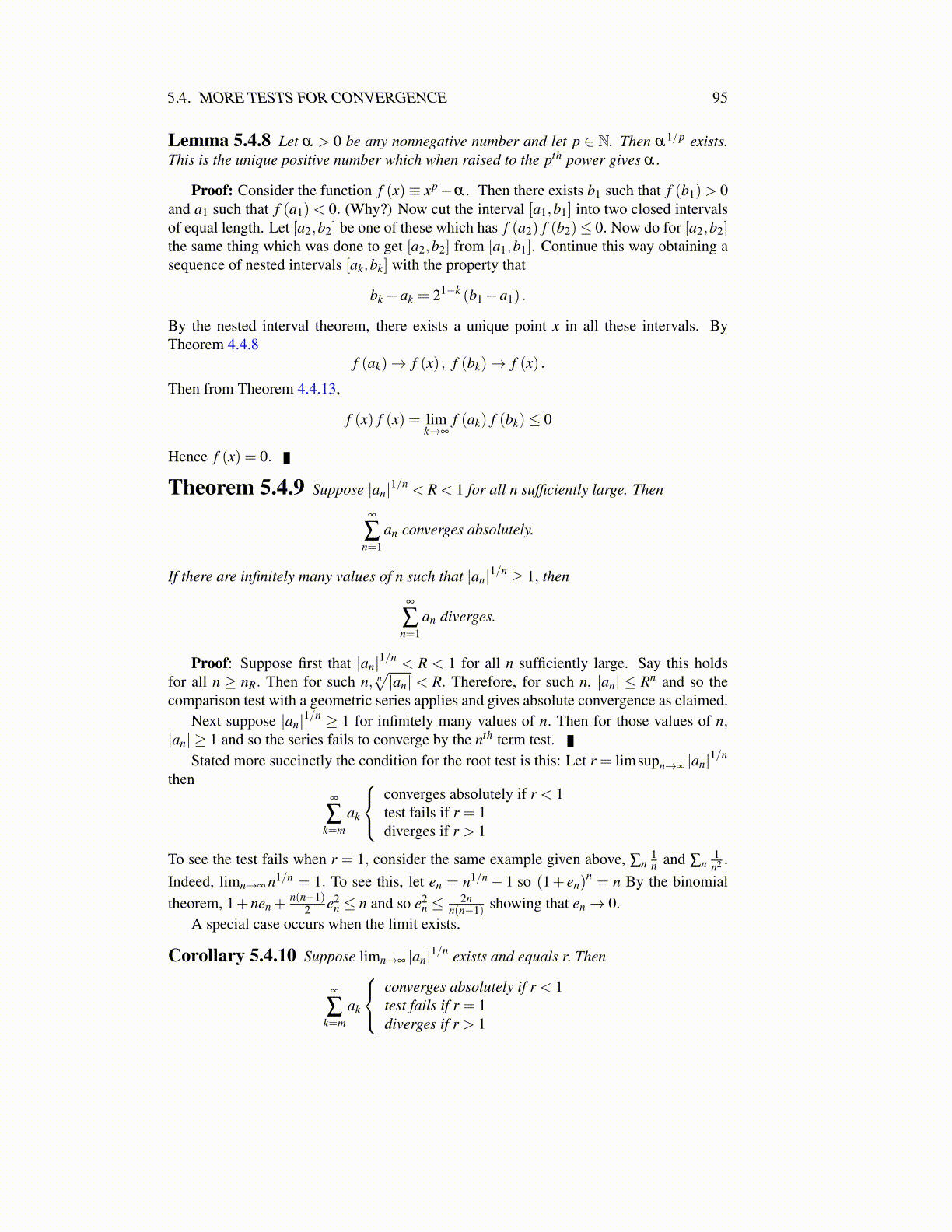
5.5. DOUBLE SERIES 95
Lemma 5.5.2 If {An} is an increasing sequence in [−∞,∞], then sup{An}= limn→∞ An.
Proof: Let sup({An : n ∈ N}) = r. In the first case, suppose r < ∞. Then letting ε > 0be given, there exists n such that An ∈ (r− ε,r]. Since {An} is increasing, it follows ifm > n, then r− ε < An ≤ Am ≤ r and so limn→∞ An = r as claimed. In the case wherer = ∞, then if a is a real number, there exists n such that An > a. Since {Ak} is increasing,it follows that if m > n, Am > a. But this is what is meant by limn→∞ An = ∞. The othercase is that r =−∞. But in this case, An =−∞ for all n and so limn→∞ An =−∞.
Theorem 5.5.3 Let ai j ≥ 0. Then ∑∞i=1 ∑
∞j=1 ai j = ∑
∞j=1 ∑
∞i=1 ai j.
Proof: First note there is no trouble in defining these sums because the ai j are allnonnegative. If a sum diverges, it only diverges to ∞ and so ∞ is the value of the sum. Nextnote that ∑
∞j=r ∑
∞i=r ai j ≥ supn ∑
∞j=r ∑
ni=r ai j because for all j, ∑
∞i=r ai j ≥∑
ni=r ai j.Therefore,
using Lemma 5.5.2,∞
∑j=r
∞
∑i=r
ai j ≥ supn
∞
∑j=r
n
∑i=r
ai j = supn
limm→∞
m
∑j=r
n
∑i=r
ai j
= supn
limm→∞
n
∑i=r
m
∑j=r
ai j = supn
n
∑i=r
limm→∞
m
∑j=r
ai j
= supn
n
∑i=r
∞
∑j=r
ai j = limn→∞
n
∑i=r
∞
∑j=r
ai j =∞
∑i=r
∞
∑j=r
ai j
Interchanging the i and j in the above argument proves the theorem.The following is the fundamental result on double sums.
Theorem 5.5.4 Let ai j ∈ F and suppose ∑∞i=r ∑
∞j=r∣∣ai j∣∣ < ∞. Then ∑
∞i=r ∑
∞j=r ai j =
∑∞j=r ∑
∞i=r ai j and every infinite sum encountered in the above equation converges.
Proof: By Theorem 5.5.3 ∑∞j=r ∑
∞i=r∣∣ai j∣∣ = ∑
∞i=r ∑
∞j=r∣∣ai j∣∣ < ∞. Therefore, for each
j, ∑∞i=r∣∣ai j∣∣ < ∞ and for each i, ∑
∞j=r∣∣ai j∣∣ < ∞. By Theorem 5.2.2 on Page 85, both of
the series ∑∞i=r ai j, ∑
∞j=r ai j converge, the first one for every j and the second for every i.
Also, ∑∞j=r∣∣∑∞
i=r ai j∣∣≤∑
∞j=r ∑
∞i=r∣∣ai j∣∣< ∞ and ∑
∞i=r∣∣∑∞
j=r ai j∣∣≤∑
∞i=r ∑
∞j=r∣∣ai j∣∣< ∞ so by
Theorem 5.2.2 again, ∑∞j=r ∑
∞i=r ai j, ∑
∞i=r ∑
∞j=r ai j both exist. It only remains to verify they
are equal. By similar reasoning you can replace ai j with Reai j or with Imai j in the aboveand the two sums will exist.
The real part of a finite sum of complex numbers equals the sum of the real parts.Then passing to a limit, it follows Re∑
∞j=r ∑
∞i=r ai j = ∑
∞j=r ∑
∞i=r Reai j and similarly, one
can conclude that Im∑∞i=r ∑
∞j=r ai j = ∑
∞i=r ∑
∞j=r Imai j. Note 0 ≤
(∣∣ai j∣∣+Reai j
)≤ 2
∣∣ai j∣∣ .
Therefore, by Theorem 5.5.3 and Theorem 5.1.5 on Page 84∞
∑j=r
∞
∑i=r
∣∣ai j∣∣+ ∞
∑j=r
∞
∑i=r
Reai j =∞
∑j=r
∞
∑i=r
(∣∣ai j∣∣+Reai j
)
=∞
∑i=r
∞
∑j=r
(∣∣ai j∣∣+Reai j
)=
∞
∑i=r
∞
∑j=r
∣∣ai j∣∣+ ∞
∑i=r
∞
∑j=r
Reai j
=∞
∑j=r
∞
∑i=r
∣∣ai j∣∣+ ∞
∑i=r
∞
∑j=r
Reai j